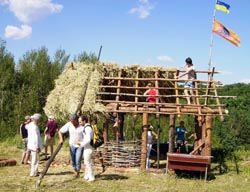Trypillian entertainments at ecocultural festival
Building a house from 4th century B.C.
The two-day 2008 Trypillian Circle Water Festival took place on the outskirts of the village of Rzhyshchiv in Kyiv oblast, in a huge field that was divided into two main areas: a tent village for overnight guests and a fair for those who love to shop. The shopping area featured an array of sale items, including Ukrainian embroideries, coral beads, CDs of ethnic music, and various earthenware items.
The visitors did not seem to be all that impressed by the wares, so they followed their maps distributed free to all guests to find the entertainment grounds, where there was sports competition of endurance and strength, and a succession of performances by folk groups from Ukraine, Belarus, and Macedonia. Visitors who still had some energy and a desire to continue wandering through the festival grounds reached the most interesting area, where the construction of a Trypillian house was taking place.
According to the organizers’ plan, over the course of two days volunteers and experts on Trypillian architecture had to recreate a typical house of our distant ancestors: a two-storied building made of wood, straw, and wicker.
“To reproduce a Trypillian house on time for the end of the festival, we prepared the wooden structure-the walls and the roof-several days before the festival opened,” said Vladyslav Chabaniuk, one of the construction workers and a researcher employed at the State Historical and Cultural Park of Trypillian Culture.
“Then we only had to thatch the roof with straw, weave wicker to make the walls, and cover them with clay. The straw for the roof of this Trypillian house is pure guesswork because we do not have exact data on what the Trypillian people used to cover their roofs, whether they used wicker or reeds to make the walls, what kind of wood they used for the frame, etc. Most likely, they used reeds for the roof because this material offers good protection from rain and heat. We know that the classic Trypillian house is 4 by 4.5 meters, but at the festival we built a dwelling half this size because of time constraints.”
What will happen with the Trypillian house after the festival is anyone’s guess, but it may be moved to the National Park of Trypillian Culture.
The blacksmith Dmytro Nazarenko knew that his products would be purchased by festival goers and his shop would go back home with him because it is mobile. “The technique for operating this kind of miniature blacksmith’s shop is very simple,” Nazarenko explained. “You take some coal, make it red-hot using bellows, put a piece of iron in it, and heat it up well. Then it is ready to be forged. Sometimes I don’t know what the end product will be: a flower, weapon, or little bracelet.”
At the end of the first Trypillian festival the organizers promised that similar events will be held every year, dedicated to the other elements of nature: earth, fire, and air.






